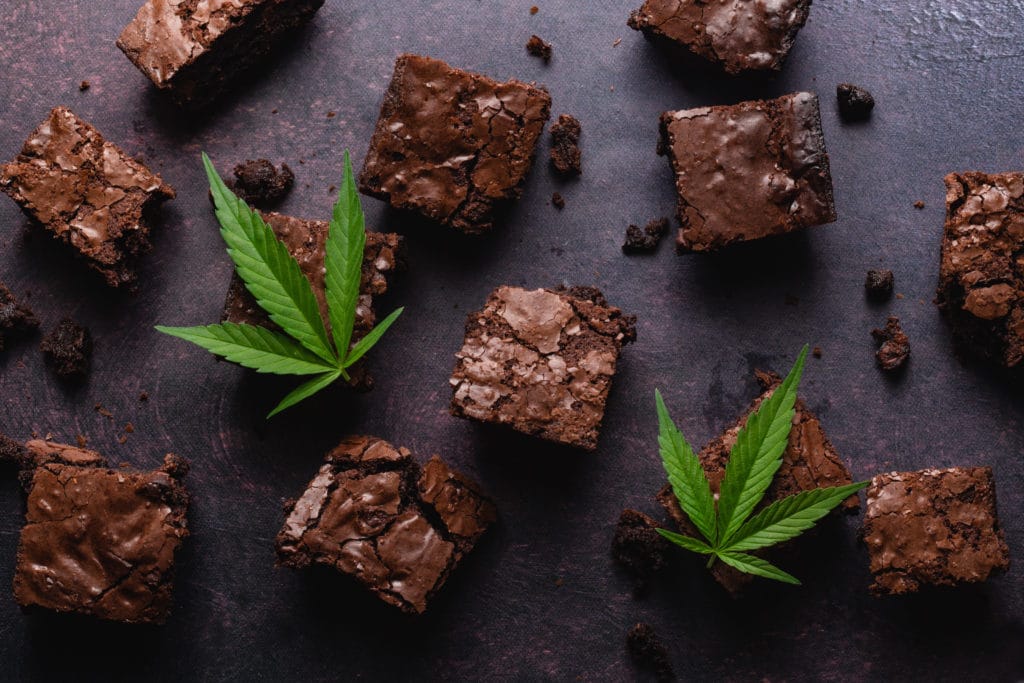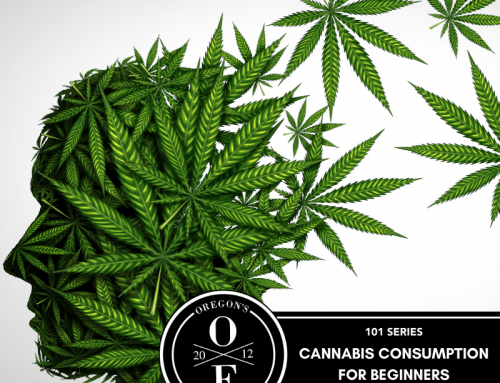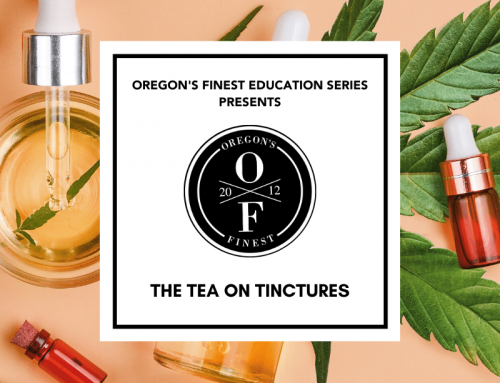Author: Sam Villegas

With no shortage of anxiety nowadays, cannabis sales are surging. Clearly many of us are turning to cannabis to calm the quarantine blues. It’s not a surprise either that with the extra time spent at home, we’re beginning to ask more questions about cannabis than ever before. These conversations are carried into the workplace, especially at a dispensary. Recently, one of my esteemed colleagues confided in me that he ate a whole bag of chocolate chips at three in the morning, in the dark, as they melted into the palm of his hand. It’s not surprising, as most of us have been confronted with the demon of insatiable hunger after a night of consuming THC. This, my friends, is also known as the munchies.
Appetite in Overdrive
When you consume THC a physiological process starts where THC begins binding to the CB1 receptors. This begins to affect your body’s physiology in a few different ways. THC continues binding to receptors located on nerve terminals that make synaptic connections to POMC neurons, among others [2]. This then begins to affect the neurons responsible for inhibiting appetite [2]. It was observed that when it binds to the CB1 receptor it stimulates the release of an appetite-stimulating neuropeptide, beta-endorphin, while also not releasing a peptide that can suppress appetite that’s located in the same neuron [2].
Ghrelin
Typically, these neurons help suppress cravings, but now they’re amplified [2]. THC can also promote the release of “ghrelin”, a hormone that has appetite-stimulating or, orexigenic, properties and is referred to as “the hunger hormone”[3]. When we get hungry our bodies are in a physiological condition that lets us know that we need to find and consume food [1]. Researchers have also found that our brain plays a huge role in why food tastes so much better after a bowl/brownie which coupled with the ghrelin release makes the increase in appetite feel so extreme.
Food Just Tastes Better
In a 2014 research paper published in Nature Neuroscience, the study points out that during this same binding process to receptors in the brain’s olfactory bulb increases the taste and smell of food [1] The article stated that researchers “found that CB1 receptor signaling in the olfactory bulb increases odor detection and proportionally promotes food intake, thereby linking hunger, olfaction and food intake”[1]. Simply, cannabis makes food taste better. All this creates a perfect storm of hunger, which leads us to eat when we otherwise may not have. This within itself is providing people that suffer from HIV, cancer, anorexia, and a myriad of other diseases that reduce appetite in patients.

Cannabis Inducing Appetite in HIV/AIDS Patients
In 1981 a San Francisco woman named Ruth “Brownie Mary” Rathbun was arrested for selling her famous, you guessed it, “pot brownies”. Her sentence was community service, which she spent helping people sick with the virus HIV. She developed a family there and was giving away an estimated 1.600 brownies to AIDS patients. A decade later, Brownie Mary, alongside other activists would begin to fight for the legalization of cannabis, which eventually led to the first medical cannabis program.
Cannabis can assist in more ways than just stimulating appetite, including pain relief. In a 2011 study titled A Pilot Study of the Effects of Cannabis on Appetite Hormones in HIV-infected Adult Men. This study shows promise for utilizing cannabis to treat symptoms beyond inducing hunger. Cannabis also provided an analgesic response in patients with pain related to HIV sensory neuropathy [4]. The study found that when compared to the placebo administered, cannabis was able to stimulate appetite by modulating the endocannabinoid system [4]. The researchers noted that there was a plasma increase of ghrelin, recognizing that to be linked with cannabis consumption [4].
Cancer
The effects of cancer and forms of treatment can halt an appetite causing more issues for the patient. Cannabis has previously been used to help chemotherapy-associated nausea and vomiting due to antiemetic properties[5]. Cannabis can also help with pain and issues of neuropathy associated with certain cancers as well. The 2015 study points out that cannabis is a useful treatment for patients going through chemotherapy due to phytocannabinoids’ ability to modulate pain, control of movement, and memory [5]. A 2016 study does make mention of a large study of 469 advanced cancer patients “experienced a significantly greater increase in both weight and appetite” [6]
Anorexia

Symptoms include
In the research paper The Cannabinoid Receptor Agonist THC Attenuates Weight Loss in a Rodent Model of Activity-Based Anorexia, researchers set out to find if cannabis can be helpful in anorexia nervosa. Anorexia traditionally happens during adolescence but can occur at any age.
- severe food restriction
- food-related anxiety
- rapid weight loss
- increased physical activity
- severe anhedonia (reduced pleasure)
The endocannabinoid system’s primary function is to keep the body in a state of homeostasis by regulating your mood, movement, metabolism, and more. The 2011 study points out that that when we consume THC reward pathways and the endocannabinoid system both regulate food intake. It was shown that THC significantly helped the reduction of weight loss [7]. They observed the endocannabinoid system was helpful in assisting with animal-based trials [7]. The study goes on to say that “these results from the animal-based model of AN highlight the potential of cannabinoids and of the endocannabinoid system in the treatment of human anorexia” [7].
Whether cannabis has been able to provide the ability to get an appetite back due to another underlying condition or causes you to search for chocolate chips in the dead of night, the munchies aren’t going anywhere.
References
[1] Soria-Gómez, E., Bellocchio, L., Reguero, L. et al. The endocannabinoid system controls food intake via olfactory processes. Nat Neurosci 17, 407–415 (2014). https://doi.org/10.1038/nn.3647
[2] S. D. Patel and R. D. Cone, “A cellular basis for the munchies,” 05-Mar-2015. [Online].
Available: https://www.nature.com/articles/nature14206.pdf. [Accessed: 05-Mar-2020].
[3] Pradhan, G., Samson, S. L., & Sun, Y. (2013). Ghrelin: much more than a hunger hormone. Current opinion in clinical nutrition and metabolic care, 16(6), 619–624. https://doi.org/10.1097/MCO.0b013e328365b9be
[4] Riggs PK, Vaida F, Rossi SS, et al. A pilot study of the effects of cannabis on appetite hormones in HIV-infected adult men. Brain Res. 2012;1431:46-52. doi:10.1016/j.brainres.2011.11.001
[5] Abrams, DI, & Guzman, M. (2015). Cannabis in cancer care. Clinical pharmacology and therapeutics, 97(6), 575-586. http://dx.doi.org/10.1002/cpt.108 Retrieved from https://escholarship.org/uc/item/6367m6vj
[6] Abrams D. I. (2016). Integrating cannabis into clinical cancer care. Current oncology (Toronto, Ont.), 23(2), S8–S14. https://doi.org/10.3747/co.23.3099
[7] Verty, A. N., Evetts, M. J., Crouch, G. J., McGregor, I. S., Stefanidis, A., & Oldfield, B.
- (2011). The cannabinoid receptor agonist THC attenuates weight loss in a rodent model of activity-based anorexia. Neuropsychopharmacology : official publication of the American College of Neuropsychopharmacology, 36(7), 1349–1358. https://doi.org/10.1038/npp.2011.19



